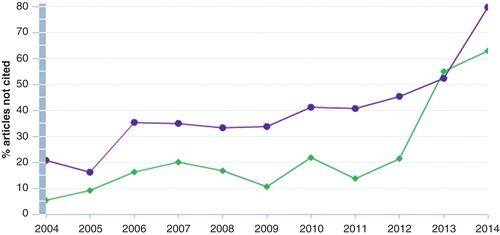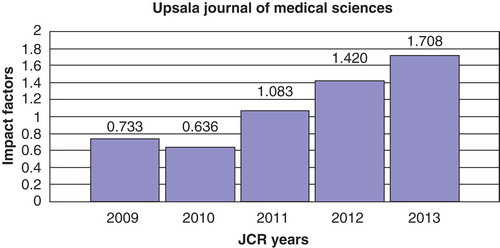When we approached our readers two years ago to comment upon the newly released Impact Factor scores from Thomson Reuters (TR) we were happy to announce that for the first time we had passed the critical 1.0 level (Citation1). This time we are glad to let you know about a further increase of this long-questioned instrument for measuring the quality of scientific journals (). After a 33% increase last year and 21% this year we have now established ourselves in the 1.0–2.0 interval with the new figure of 1.708 as a new top score for the journal. Besides the actual increase of the impact figure we have also advanced in the ranking of 150 journals in our category ‘Medicine, General and Internal’ from 83rd place two years ago up to 55th this year. Last time we promised/aimed at belonging to the better half of the ranking list in the list to come. That goal has been fulfilled in full measure. Perhaps belonging to the best third, next time?
One more figure that has increased over the last few years is that of ‘total cites’. That is not only citations during one particular year from the ‘impact factor years’ but all other years as well. By necessity that type of figures should constantly increase, keeping in mind the increasing numbers of journals and articles. Well above 500 for our journal this year mainly reflects increases of citations to latest years’ papers. It is also worthy of note that the figure is that high despite a fairly low self-citation figure for our journal—3%. For many journals that figure approaches 10%. This is not to say that we intend to become more active in that respect. Thus, so-called coercive citation (forced citations to own journal) is not an instrument that we will use or have used.
A prerequisite for increasing the impact factor figure is of course that the quality of our published papers is high enough to attract the interest of our readers. For that purpose a high submission rate is crucial, and we are glad to see that preliminary figures for this year tell that we will have handled more than 300 manuscripts. Our four issues will accommodate some 50–60 contributions, which means that no less than some 80% of the submitted manuscripts have to be rejected. Perhaps one reason for the high submission rate is our policy of not charging authors any handling fees. Processing that many manuscripts is costly and even with the introduction of a system with many associate editors to share the burden (Citation2) it might be necessary to change our policy with regard to processing charges.
One obvious reason for our increase of the impact factor figure this year is the inclusion in the 2012 volume of a special issue on tumour biology edited by Bengt Westermark and Carl-Henrik Heldin (Citation3). All of the published articles have been cited, and the most highly cited one, that by Nazarenko and co-authors (Citation4), has got 20 citations to date (August 2014). That means that it will belong to the group of the 1% most-cited (22 citations required) articles published in 2012 (Citation5). Five other articles have passed the 10% limit (8 citations required). Of course this stimulates us to pursue our plan with publication of one such issue with a specified topic every second year. Antibiotic resistance was the subject of this year’s issue (Citation6), and in the year 2016 we intend to publish one on diabetes research. And even before that, that is next year, we are going to celebrate our 150th anniversary with a special jubilee issue.
As pointed out at the very beginning of this editorial, the use of impact factor figures for measuring different quality aspects of scientific journals has been much debated. However, there are not very many useful alternatives. The citation database Scopus of Elsevier publishes a journal analyser that amongst many things contains the SJR (SCImago Journal Rank) metrics. Although it is hard to understand how the actual figures have been calculated, the ranking is said to be ‘weighted by the prestige of a journal, etc.’ An impressive three-fold increase of the value for our journal is, nevertheless, obvious from 2010 to 2013 (). More clear-cut are the figures in that database concerning ‘Percent Not Cited’. Interestingly, the highest ranked journal of our category in Thomson Reuters (New England Journal of Medicine) has got much higher figures (mainly around 30%) than our journal (between 10% and 20%) (). Most certainly, it reflects how much the citation rates of individual articles vary in each separate journal. It also demonstrates that the acceptance of a manuscript for publication in a highly ranked journal does not by necessity guarantee that it will be much cited.
Figure 2. SCImago Journal Rank for Upsala Journal of Medical Sciences as of 13 June 2014 in Scopus (Elsevier).

Figure 3. Percentage of papers not cited; Upsala Journal of Medical Sciences (diamonds—green symbols) and New England Journal of Medicine (circles—black symbols) as of 29 June 2014 in Scopus (Elsevier).

Although we have dwelt upon this before, we would like to stress that the number of local, Uppsala-based contributions—less than 40% last year—is fairly low, which means that there is room for more of them. It can also be argued that this points to the fact that our journal is a truly international one. Indeed, last year we received submissions from more than 30 countries.
Finally, we would like to announce that our editorial assistant Rikard Fred has moved to Lund for a post-doc position down there. We thank him very much for many valuable contributions over the last two years. He will be replaced by Joey Lau, and we warmly welcome her to this task.
Arne Andersson
Editor
Declaration of interest: The author reports no conflicts of interest. The author alone is responsible for the content and writing of the paper.
References
- Andersson A, Ronquist G. A substantial increase of the impact factor. Ups J Med Sci. 2012;117:353–4.
- Andersson A, Karlsson T. Editorial. A change of the editorial machinery. Ups J Med Sci. 2013;118:1–2.
- Weinberg R. Bengt Westermark and our current understanding of tumor pathogenesis. Ups J Med Sci. 2012;117:81–2.
- Nazarenko I, Hede S-M, He X, Hedren A, Thompson J, Lindström MS, et al. PDGF and PDGF receptors in glioma. Ups J Med Sci. 2012;117:99–112.
- Karlsson S. Den svenska produktionen av högt citerade vetenskapliga publikationer. Vetenskapsrådets Lilla Rapportserie. 2010;1:1–21.
- Davies J. Antibiotic resistance and the golden age of microbiology. Ups J Med Sci. 2014;119:65–7.

